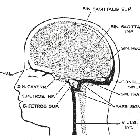inferior petrosal sinus sampling
Inferior petrosal sinus sampling is an infrequently used method of confirming the presence of a hormonally active pituitary microadenoma when imaging alone has been insufficient. This technique is able to confirm that excess hormone (e.g. ACTH) is being produced by the pituitary and may also help in lateralizing the microadenoma (although the later is more contentious).
Indication
Inferior petrosal sinus sampling is most frequently indicated when patients have confirmed ACTH dependent Cushing's syndrome. ACTH secreting pituitary microadenomas, which may be inapparent on imaging in 40 to 50% of cases, account for 80% of non-adrenal, non-iatrogenic cases.
Technique
Although technique varies a standard modern approach would consist of:
- one sheath should be over-sized to allow for peripheral venous sampling, or alternatively, a peripheral IV can be located and a non-scrubbed assistant can withdraw the peripheral sample.
- if access to the sinus is difficult then an arterial puncture can be performed to enable a common carotid injection and road mapping of the IPS
- it is important to note that in ~7% of patients the inferior petrosal sinus does not drain into the jugular bulb, but rather directly into the vertebral venous plexus
- one of the greatest pitfalls is mislabeling the numerous samples. Ideally, 5 personnel are required. Three to aspirate, one to transfer into the EDTA tubes and another to keep track of time, etc...
Interpretation of results
IPSS is a highly sensitive and specific examination series reporting near 100% values for both. Exact ratio values will vary between institutions. Typically published ratios are:
- Pre CRH
- >1.7:1 central:peripheral = pituitary source
- <1.5:1 central:peripheral = ectopic source
- Post CRH
- >3.3:1 central:peripheral = pituitary source
- <1.8:1 central:peripheral = ectopic source
- Lateralization
- >1.4:1 interpetrosal gradient
Complications
Complications are rare, but reported, and include:
- deep cerebral venous thrombosis
- pulmonary embolism
- venous subarachnoid hemorrhage (SAH)
- brain stem ischemic injury
In a large review of 508 patients , a single complication was observed (0.2%), although a conservative 1% incidence of serious complications has been suggested be quoted.
Siehe auch:
- Lungenarterienembolie
- Sinusthrombose
- Mikroadenom Hypophyse
- inferior petrosal sinus
- Cushing-Syndrom
- deep cerebral venous thrombosis
und weiter:

 Assoziationen und Differentialdiagnosen zu inferior petrosal sinus sampling:
Assoziationen und Differentialdiagnosen zu inferior petrosal sinus sampling:





